 |
surfresearch.com.au
surfing
images : 1788 to 1870 |
| home | catalogue | history | references | appendix |
|
|
|
|
|
|
|
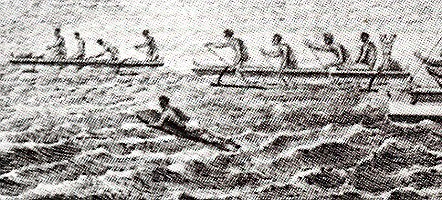 |
First drawing of a surfboard, circa 1778. Detail from ... "A View of KaraKakooa, in Owyhee." Cropped from Finney and Houston (1996) Page 12 First image of surf board. |
Cropped from Finney
and Houston (1996) Page 12
Various resized
and/or cropped versions are also printed in
| Finney and Houston (1966) Plate 1. | Lueras (1984) Pages 44 - 45 and 47 |
| Margan and Finney (1971) Pages 20 - 21. | Kampion (1997) Page 32. |
| Nat's History (1983) Page 33. | DelaVega (ed, 2004) Page 15. |
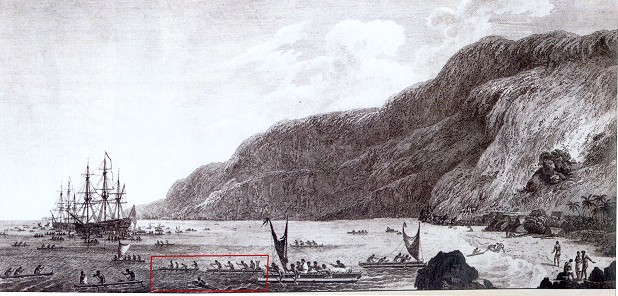
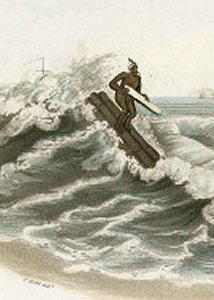 |
Madrassan men surfing,1800 (detail). Colour aquatint on
paper
|
To the left, it shows
one man riding a three-log
catamaran shore ward on a considerable
wave.
He rides upright,
with his feet parallel, and holding a paddle, while at the illustration's
centre, two men are seen on a similar craft in the second line of breakers.
A masula,
also known as masoola or
masulah, a local surf boat with
a crew of six, is heading through the outside breakers, transporting freight
for the ships of the East India Company, awaiting off-shore at the Madras
Roads.
At the turn of the 20th century, the catamaran surfing technique was replicated with the development of stand-up paddleboards (SUPs).
For a detailed analysis
see Source Documents:
1800 Charles
Gold : Catamaran Surfing,
Madras.
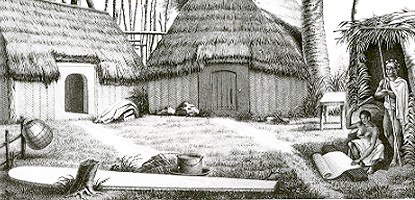 |
or Alphonse Pellion ? : "The Houses of Kraimokou, circa 1819." Finney and Houston (1996) Page 37.. First image of an Olo board. |
A wonderfully detailed
ilustration of Hawaiian dwellings, with the chief in ceremonial dress and
his wife beating tapa cloth. Like all the other early images, she is bare
breasted.
The large Olo board
takes a central position in the drawing and presumably a similar culutural
position.
The buildings closely
resemble a house initally drawn by John Webber in 1779 titled "An Offering
before Capt Cook in the Sandwich Ilses".
An engraving, based
on the drawing by S. Middleman and J. Hall, was included in Cook's
published journals in 1884.
Beaglehole
(1974)
Plate
41, between pages 672 and 673.
'' The artwork
from Freycinet's circumnavigation on the Uranie includes original drawings
taken 'd'aprés nature' by Arago, Taunay and Pellion on the voyage.''
http://www.liswa.wa.gov.au/freycinet/pages/campperon.html
"The collection
of drawings which Captain Freycinet has brought home from his voyage round
the world . . . affords the strongest proof of the unwearied zeal and remarkable
intelligence of M. Arago, the draftsman to the expedition" - from the
introduction to Arago ? by Forbes.
(p. xxvi). Borba
de Moraes I, p. 44. Brunet I, 372. Ferguson 885. Forbes I, 562. NMMC I,
154. Sabin 1865. BT000064.
Items featured
in the Freycinet Collection
http://www.liswa.wa.gov.au/freycinet/pages/items.html
Vice-admiral Alphonse
Odet-Pellion
http://www.netmarine.net/tradi/celebres/odetpellion/index.htm
French, available in translation by google.com
First printed in
Freycinet, L :
Voyage autour du mode ... 1817 - 1820. (Voyage around the world ...
1817 - 1820.)
Chez Pillet aine,
Paris. 1825,
Volume 2, Part 2,
Book 4, Chapter XXVII, Pages 517 to 622 (?).
Dela
Vega (ed, 2004) page 20.
Also
Arago, J : Narrative
of a Voyage round the World, in the Uranie and Physicienne Corvettes,
Commanded by
Captain Freycinet, During the Years 1817, 1818, 1819, and 1820.
Treuttel and Wurtz,
Treuttel, Jun. and Richter. London. 1823.
. . . With Twenty-Six
Engravings . . . . :
Folding frontispiece
map and twenty-five lithographed plates after Arago.
Also
Arago, J : Recollections
of a Blind Man
Cited by Finney
and Houston (1996) Page 38.
For an early copy
of the image (credited Alphonse Pellion), see
http://www.hawaii.edu/lruby/hon291/hon291.htm
Scanned from Finney
and Houston (1996) Page 37.
Various resized
and/or cropped versions are also printed in
| Finney and Houston (1966) Plate 12. | Finney and Houston (1996) Page 37. |
| Margan and Finney (1971) Page 19 | Dela Vega (ed, 2004) page 20. |
| Nat's History (1983) Page 33 (badly cropped) | Lueras (1984) Page 35. Colourised, see below. |
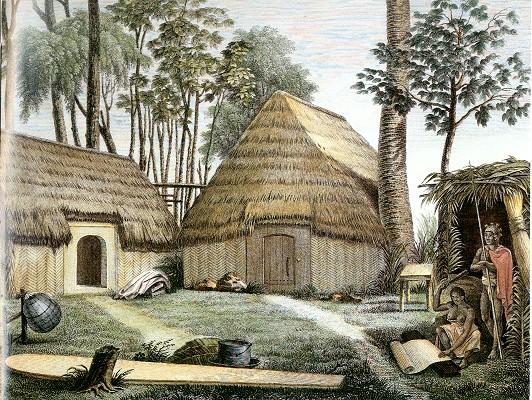 |
or Alphonse Pellion ? : "The Houses of Kraimokou, circa 1819." Lueras
(1984) Page 35.
First image of an Olo board. |
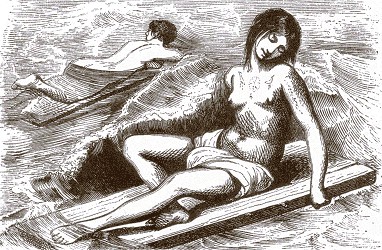 |
"Wahine, Hawaii, circa 1819." Finney
and Houston (1996) Page 38.
Decorative, rather than informative. |
The fascination with the naked female breast can be, perhaps, assessed by a desciption of a young aboriginal woman by Watkin Tench, a British Army officer posted to the initial occupation of Australia at Sydney Cove in 1788 ... "She excelled in beauty all their females I ever saw.
Scanned from Finney
and Houston (1996) Page 38.
Various resized
and/or cropped versions are also printed in
Finney
and Houston (1966) Page 43, Figure 5.
Margan
and Finney (1971) Page 19.
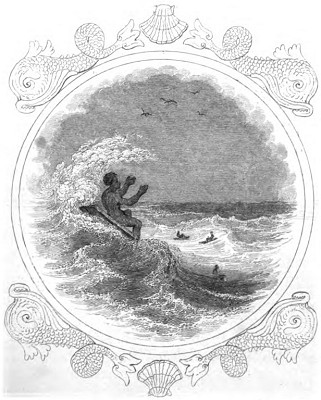 |
Surf Swimmers (Sandwich Islands) Illustration
from
|
The Ship was
one of The Little Library series, written for juvenlie readers, comprising
"eighteen small volumes uniformly printed, a familiar
Introduction to
various branches of useful knowledge."
It was published
in a number of editions in the 1830s, and subsequently reprinted several
times before 1854.
In the text, the
father, Mr. Nauticus (addressed as "Papa"), has an extended conversation
about the origin and history of ships with his young
sons; Charles, Richard,
and William.
As well as the surf
riding content, there is discussion of the canoes of the Marquesa and Society,
and Friendly Islands, accompanied with an
engraving of a double
canoe, probably etched by Taylor, and based on an earlier work.
The inclusion of
this material probably indicates that it was sourced from one, or
several, of the many works detailing Pacific exploration by
British mariners,
most notably James Cook.
The illustration
Surf-Swimming (dated August 1830) is highly unusual in that the
perspective is from the water, with the curl of the wave in profile
and the shoreline
in the background, somewhat reminiscent of Hokusai's famous woodblock
print, Under the wave off Kanagawa c.1830.
Importantly, the
board is placed on the wave face, unlike many subsequent illustrations
that show the rider on the back of the wave.
It precedes, by
the slightest of margins, the widely reproduced Sandwich Island Surf-riders,
attributed to F. Howard and first published in Rev.
William Ellis' Polynesian
Researches in 1831, see below.
For the full relevant
extracts, see Source Documents:
1830 Issac Taylor : Surf
Riding in Hawaii.
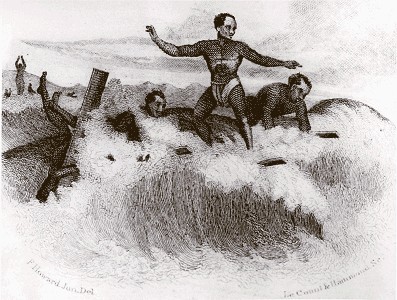 |
"Sandwich Island Surf-riders, circa 1830." Finney and Houston (1996) Frontpiece. The first reported
Western image of surf-riding,
|
The "Sandwich Islands" was the name originally given to the Hawaiian Islands by Cook for a friend and patron, John Montague, the fourth Earl of Sandwich (as in the "invention" of a piece of meat between two slices of bread). Montague was the the current first Lord of the Admiralty.The description was used up to the late19th century.
Scanned from Finney
and Houston (1996) Frontpiece.
Various resized
and/or cropped versions are also printed in
Finney
and Houston (1966) Frontpiece. A particually poor reproduction,
unlike the other images in this book.
George
(1990) Page 21.
Dela
Vega (ed, 2004) Pages 18 -19.
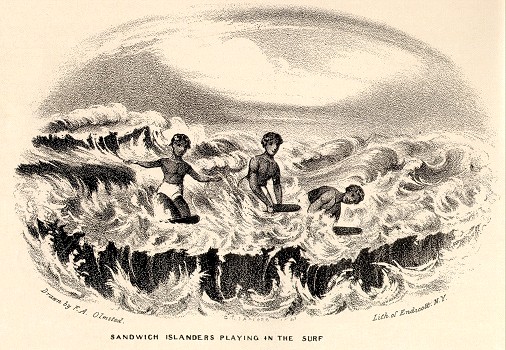 |
"Sandwich Islanders Playing in the Surf, circa 1841." .Lueras (1984) Page 39. First image by the
same writer
|
Scanned from Lueras
(1984) Page 39.
Various resized
and/or cropped versions are also printed in
Nat's History
(1983) Page 33
Dela
Vega (ed, 2004) page 24.
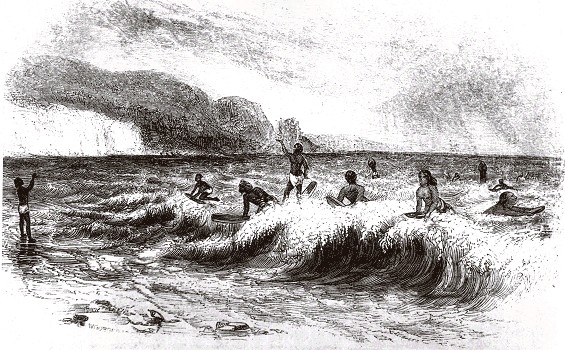 |
Cheever (1851): Hawaiian Sport of Surf Playing, circa 1851. DelaVega (ed, 2004) page 14. First Magazine article with surfing and art. |
There are two standing
'riders' further from the beach, both with their hands held directly above
their heads.
There is one similarly
positioned rider in the same stance in
F.
Howard's "Sandwich Island Surf-riders, circa 1830."
Possibly "WROBBER??"
(drawing/
woodblock/etching?)
"First Magazine
article with surfing and art." - Dela
Vega (ed, 2004) page 14.
First printing ...
Cheever, Rev. Henry
T. : Life in the Sandwich Islands, or the Heart of the Pacific, as
it was and as it is.
A.S. Barnes and
Co. NY,
Richard Bentley,
London, 1851
H.W.Derby, Cincinnati.
1851. Pages 66 to 69.
Image and surf-riding
text was reprinted (concurrently, as a promotion for the book?) in ...
Cheever, Rev. Henry
T. : "The Sandwich Islands Today"
The International
Monthly Magazine of Literature, Science and Art.
Volume IV, Number
III, October 1851, pages 298 - 299.
Stringer and Townsend,
New York,
"This publication
was short lived and was merged into Harper's Monthly in 1852."
abebooks.com
Scanned image from
DelaVega(ed,
2004) page 14.
Various resized
and/or cropped versions are also printed in
Finney
(1959) Plate 1, between pages 330 - .331.
Hawaiian surfing
scene, from Cheever 1851:68.
The artist although
ditinctly portraying the prone, kneeling and standing positions, has incorrectly
pictured the surfers riding behind the wave.
A surfer always
slides on the forward slope of the wave.
Finney
and Houston (1966) Plate 9.
Finney
and Houston (1996) Page 26.
George
(1990) Page 23
Carroll (ed.1991)
Page 16..
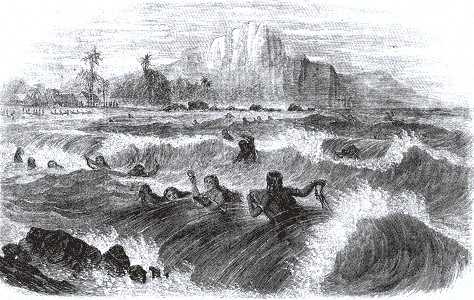 |
Surf swimming at Hawaii, Sandwich Islands, circa 1866. DelaVega
(ed, 2004)
|
First printed in
"Surf swimming
at Hawaii, Sandwich Islands."
Leslie's Illustrated
Weely,
New York Arkell
Weekly Co.
7 April 1866. Page
37.
Includes a reprint
of the previously published account by Rev.
William Ellis, 1830.
Scanned image from
DelaVega
(ed, 2004) Page 5.
|
|
|
|
|
|

| home | catalogue | history | references | appendix |